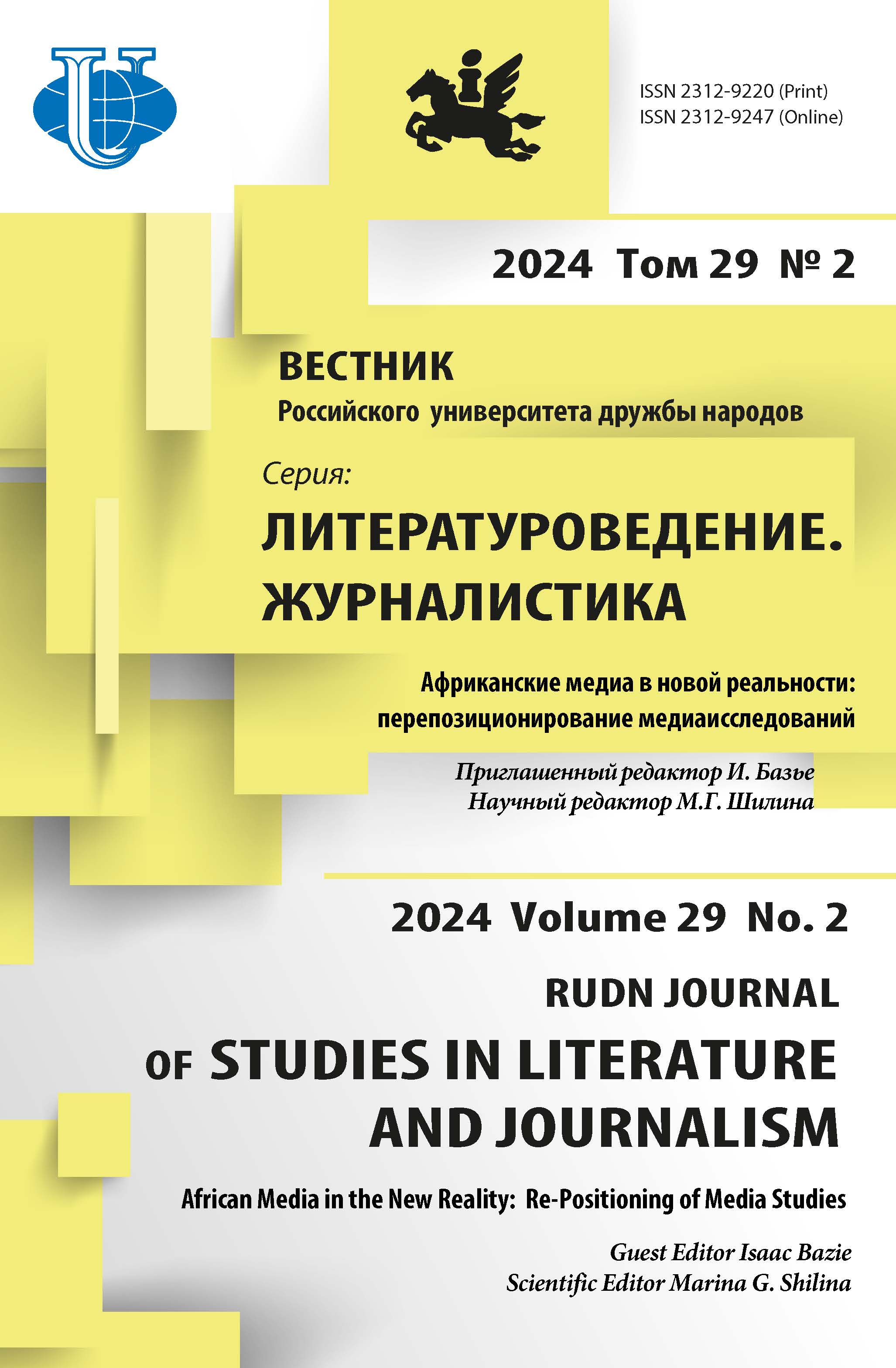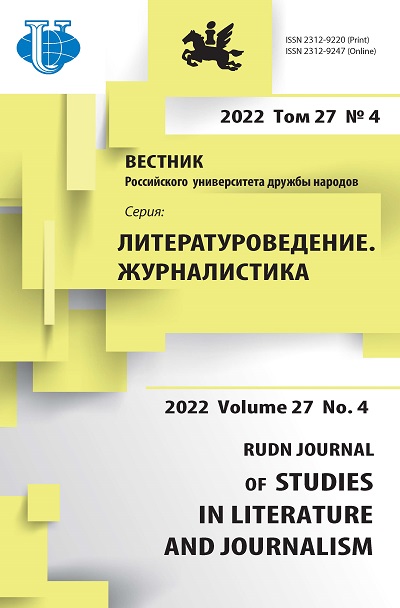Articles problematics and specificity of creative style of Iraqi publicist Raphael Butti
- Authors: Bakanov R.P.1, Al-Baidhani W.A.1
-
Affiliations:
- Kazan (Volga Region) Federal University
- Issue: Vol 27, No 4 (2022)
- Pages: 745-756
- Section: JOURNALISM
- URL: https://journals.rudn.ru/literary-criticism/article/view/33286
- DOI: https://doi.org/10.22363/2312-9220-2022-27-4-745-756
Cite item
Full Text
Abstract
The publicist and editor Raphael Butti was one of the pioneers of Iraqi social and political journalism. The study of his 400 articles between 1920 and 1956, have shown that the predominant direction of his work, the impulse for writing was the desire to promote and develop democratic institutions in Iraq. The subject matter of his publications was related to the need for freedom of choice, gender equality, freedom of speech and the press, and increasing the level of education of the individual. Applying the methods of problem-thematic, lexical-stylistic and comparative analysis of Rafael Butti's articles, the authors have revealed that almost all his articles are permeated by the theme of patriotism and reflect his broad outlook. At the same time, the relative paucity of the language and creative style of the Iraqi publicist was found, which is expressed, in particular, in the limited use of artistic expression. Rafael Butti focuses primarily on intellectual enlightenment, compensating for the lack of emotional messages with long analytical phrases, lengthy paragraphs, and lengthy headings.
About the authors
Roman P. Bakanov
Kazan (Volga Region) Federal University
Author for correspondence.
Email: Roman.Bakanov@kpfu.ru
ORCID iD: 0000-0002-1097-8390
Candidate of Philology, Associate Professor, Department of National and Global Media, Institute of Social Philosophical Sciences and Mass Communications
18 Kremlyovskaya St, Kazan, 420008, Russian FederationWaleed A.S. Al-Baidhani
Kazan (Volga Region) Federal University
Email: VSAL-Baidkhani@stud.kpfu.ru
ORCID iD: 0000-0003-0441-2021
PhD student, Department of National and Global Media, Institute of Social Philosophical Sciences and Mass Communications
18 Kremlyovskaya St, Kazan, 420008, Russian FederationReferences
- Al-Imad, F.M. (2021). The origin and first steps of the Yemeni press (XIX – mid-XX centuries). Questions of Theory and Practice of Journalism, 10(3), 514–527. (In Russ.) http://doi.org/10.17150/2308-6203.2021.10(3)
- Almashakbeh, S.S.S. (2018). Media discourse of Al Jazeera after the crisis of the siege of Qatar (on the example of the Yemeni and Syrian conflicts). World of Science, Culture, Education, (6), 639–640. (In Russ.)
- Almashakbeh, S.S.S. (2019). Arab media coverage of the Syrian armed conflict. The World of Science, Culture, Education, (2), 381–383. (In Russ.)
- Amer, M. (2013). Information war in the conditions of the political crisis in the Middle East (on the example of the satellite channel “Al Jazeera”). RUDN Journal of Studies in Literature and Journalism, (1), 113–118. (In Russ.)
- Arhitektor, Je.A. (2011). From the experience of the Department of Periodical Press in conducting an elective course “Classics of Russian Journalism”. Bulletin of the Moscow State University of Printing Arts named after Ivan Fedorov, (7), 171–180. (In Russ.)
- Ba, A.M. (2014). Modern media and their influence on the revolutionary process of the “Arab Spring”. Russian Journal of Education and Psychology, (8), 22–29. (In Russ.)
- Ba, H.A.H.A.R. (2022). Civil society in Yemen in the era of network communications and new media: On the problem of civil activism. Neophilology, 8(2), 377–384. (In Russ.) http://doi.org/10.20310/2587-6953-2022-8-2-377-384
- Baruka, B. & Ahmadulin, E.V. (2019). Features of the development of television in Jordan. The Bulletin of the Adyghe State University, the series “Philology and the Arts”, 237(2), 148–152. (In Russ.)
- Bulgaru, D.I. (2017). The use of communication management technologies by the USA in the Middle East in the conditions of the “Arab Spring”. Russia: Trends and Prospects of Development: Collection of Articles of the International Scientific and Practical Conference (pp. 126–129). Moscow: Institute of Public Information on Social Sciences of the Russian Academy of Sciences. (In Russ.)
- Chen, D. (2013). Social networks and their impact on events in the Arab States (2010–2013). Bulletin of St. Petersburg University. Series: Language and Literature, (4), 189–194. (In Russ.)
- Chernov, A.V., & Savelyeva, E.A. (2015). Media texts of Al Jazeera: Factors of consolidation or confrontation? Bulletin of Cherepovets State University, (5), 76–80. (In Russ.)
- Garifullin, V.Z. (2014). The place of Internet resources in the system of Muslim mass media. In D.L. Strovsky & O.V. Ilyina (Eds.), Intercultural Communications in the Modern World: the Role of the Media (Yekaterinburg, 17–18 April 2014) (pp. 38–41). Yekaterinburg: Ural University Press. (In Russ.)
- Garifullin, V.Z., & Abdulrahman, A.M.O. (2012). Mass media as a factor of democratization of the Arab world. In E.A. Ilyin (Ed.), Information Space of the Region: History, Modernity, Actual Problems: Collection of Scientific Articles and Materials of the All-Russian Scientific and Practical Conference (pp. 68–71). Cheboksary: I.Ya. Yakovlev Chuvash State Pedagogical University. (In Russ.)
- Grabelnikov, A.A., & Tamukh, M.A. (2012). Mass media in the Egyptian revolution of 2011. Izvestiya Penza State Pedagogical University named after V.G. Belinsky, (27), 252–255. (In Russ.)
- Isaev, L.M., Eremeeva, K.S., & Shishkina, A.R. (2021). Framing the Syrian conflict in the Russian federal media. Politeia. Analysis. Chronicle. Forecast, 101(2), 97–120. (In Russ.) http://doi.org/10.30570/2078-5089-2021-101-2-97-120
- Khodynskaya-Golenishcheva, M.V. (2015). Polycentricity versus unipolarity: the work of the media in the conditions of the “Arab Spring”. Obozrevatel – Observer, (6), 60–71. (In Russ.)
- Kochergina, M.E. (2016). New forms and methods of confrontation between Russia and the United States: Media coverage of the “Arab Spring” in Syria, the geopolitical aspect. Bulletin of the Ivan Fedorov Moscow State University of Printing, (2), 189–195. (In Russ.)
- Kuteiba, A. (2018). Features of the reflection of the Syrian military confrontation in the media of Syria, Russia and Western countries. Communicology, 6(6), 120–132. (In Russ.) http://doi.org/10.214b3/2311-30bb-2018-b-b-120-132
- Malenkikh, E.A. (2013). The role of the media in the mythologization of personality during the “Arab Spring”. Bulletin of the Russian State University for the Humanities. Series: History. Philology. Cultural Studies. Oriental Studies, (7), 65–72. (In Russ.)
- Musa, L.N. (2022). Raphael Butti: His Journalistic and Political Role (1901–1956). Journal of Imam Al-Kadhum University College, 6(1), 405–428. (In Russ.)
- Nabiullina, V.R. (2019). Pun in Arabic and English newspaper headlines. Arabistics of Eurasia, (8), 16–30. (In Russ.)
- Nabiullina, V.R. (2021). Omission in grammatical constructions of Arabic newspaper headlines. Arabistics of Eurasia, (15), 86–96. (In Russ.)
- Nafaa, D. (2015). The use of chemical weapons in Syria: Media analysis. RUDN Journal of Studies in Literature and Journalism, (4), 137–144. (In Russ.)
- Naumov, A.O. (2019). The use of “soft power” technologies during the change of political regimes during the “Arab Spring” (on the example of the “jasmine revolution” in Tunisia). International Relations, (1), 114–128. (In Russ.) http://doi.org/10.7256/2454-0641.2019.1.23575
- Neem, E.G. (2019). “Media events”: A theory that has no end? Sociological Journal, 25(4), 28–37. (In Russ.) http://doi.org/10.19181/socjour.2019.25.4.6815
- Poretskova, A.A., & Savin, N.Yu. (2021). Memes as a tool for consolidating the protest movement (on the example of short videos of the TikTok social network. Monitoring Public Opinion: Economic and Social Changes, (6), 76–96. (In Russ.) http://doi.org/10.14515/monitoring.2021.6.2030
- Sawadi, A.A. (2010). Rafael Butti – journalist (Dr. of Philology sci. diss.). Baghdad. (In Arab.)
- Simons, G. (2012). Propaganda and the information war against Syria: The last war for peace. State Administration. Electronic bulletin, (33), 1–13. (In Russ.)
- Sinan, A. (2019). The book of collateral damage. Yale University Press.
- Tailakov, T.A. (2022). Coverage of the Egyptian revolutions in social networks on Arabic content. Scientific Progress, (3), 204–211. (In Russ.)
- Tamukh, M.A. (2012). Mass media of Egypt before and after the revolution of 2011. RUDN Journal of Studies in Literature and Journalism, (2), 87–93. (In Russ.)
- Tashin, M.A.Sh. (2011). Analysis of modern mass media in Jordan. RUDN Journal of Studies in Literature and Journalism, (3), 82–86. (In Russ.)
- Vasiliev, A.M., & Zherlitsyna, N.A. (2019). Dynamics of state policy towards the media in the Middle East and North Africa. Bulletin of the Moscow State Regional University. Series: History and Political Sciences, (2), 210–221. (In Russ.) http://doi.org/10.18384/2310-676X-2019-2-210-221
- Vodianov, I.N. (2022). Features of the media discourse of Egypt. Communicology, 10(1), 129–137. (In Russ.) http://doi.org/10.21453/2311-3065-2022-10-1-129-137
- Volkova, I.I., & Ashur, Kh.Yu.D. (2021). The media image of Jordan in the Internet media of the Runet: Features of “non-personalization.” Theoretical and Practical Issues of Journalism, 10(1), 39–50. (In Russ.) http://doi.org/10.17150/2308-6203.2021.10(1)
















